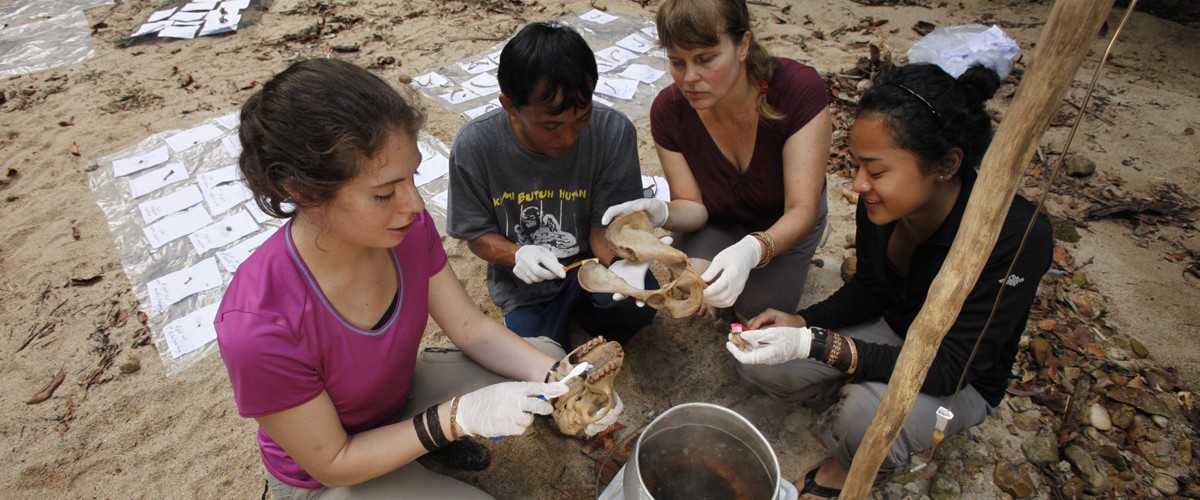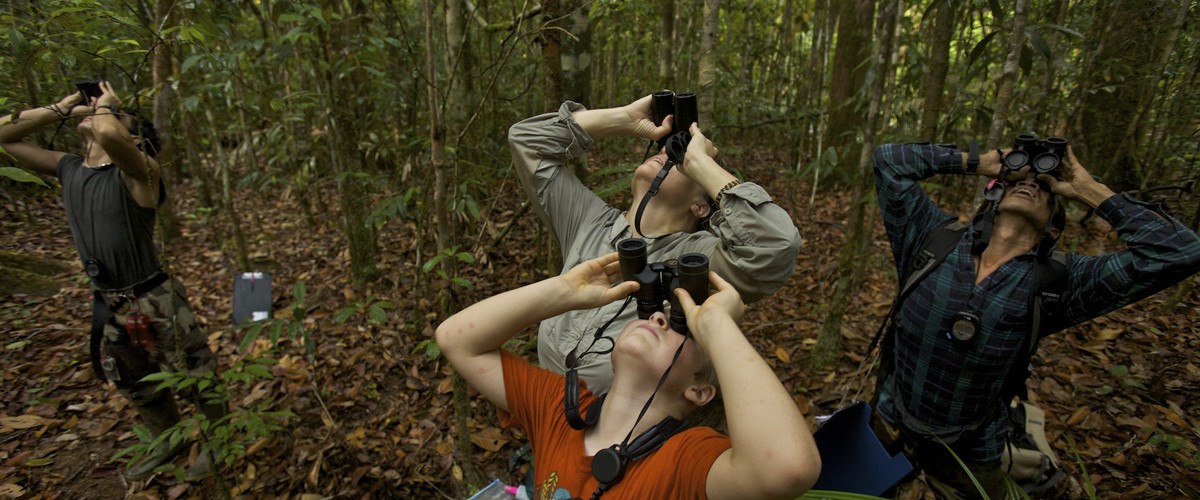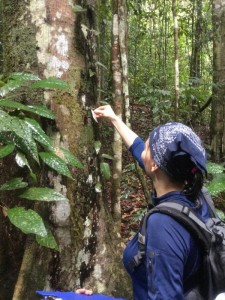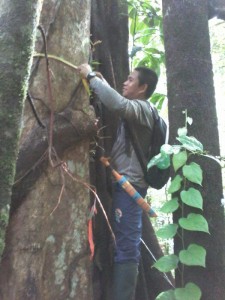Starting a dissertation is one of the most challenging and exciting periods of a graduate student”s life. I arrived in Indonesia in February, full of excitement and some anxiety. Since then, I have spent the last 2.5 months beginning my PhD research in Gunung Palung National Park. My project investigates if orangutans are foraging for specific nutrients (e.g., protein, carbohydrates, lipids) as they search for food every day. I am hopeful that this research will offer insights into the evolution of the orangutan and human diet and the modern obesity epidemic, and also provide information critical to orangutan conservation.
Like most PhD students, I”ve hit many bumps in my research plan, which make the successes all the sweeter. My time here began by hiring my botany assistant, Albani, who assesses the availability of fruit, flowers and new leaves in 17 plots throughout the forest each month. I”m very grateful to get to work with Albani, as he trained me in phenology when I first visited GPNP in 2012. Albani and I spent a month re-creating the orangutan-specific phenology plots initially used by Dr. Cheryl Knott, which meant hiking almost every trail in Cabang Panti, searching for trees that hadn”t been surveyed in 10 years. Our success rate was low – the natural turnover of rainforest trees as well as the impact of past logging made this task a difficult one. However, we have now located more than 1,100 trees across all of the plots and have even finished our first round of monthly phenology data! Then in mid-April, I was joined by Katie, my tree climbing assistant. Together we will be climbing trees that orangutans have fed on to collect samples for nutritional analysis.
My PhD project has 4 major components. The first is to carry out the regular phenology surveys, through which I will determine what orangutan foods, in what quantities and which maturity stages, are available each month. Second, I follow orangutans and take detailed data on what they are eating. I also note where in the tree they are eating so we can go back and collect similar foods from the same place, because fruit at the very top of the tree may be nutritionally different from the fruit growing near the bottom. Component three is collecting samples of orangutan foods. I am attempting to collect samples of foods that we have not yet analyzed for their nutritional content – focusing on bark, leaves, and flowers. These foods comprise the “fall-back foods” of orangutans – foods that are not preferred when fruit is abundant, but that get them through the crunch periods when fruit is scarce. Interestingly, I have observed that even when there is fruit available, orangutans eat at least a small amount of leaves, bark, termites or other non-fruit food, and I want to know why. Is there a nutrient that they need to get a minimum of to have a balanced diet? Or is there another reason that we are yet unaware of?
To get our hands on these samples, Katie and I are using every trick we can muster. Because I am interested in collecting samples from the exact spot in the tree that the orangutan ate from, we cannot just collect them from the forest floor. Each time an orangutan eats during a follow, we are presented with a new puzzle as to how to collect that specific food sample. Sometimes we use a bow-and-arrow and climbing throw-bags with rope to shake down leaves from smaller trees, whereas sometimes we have to climb high into the canopy to reach the right branch. Thus far, we have successfully collected all of the samples from one full day orangutan follow, including bamboo umbut (the “heart” or “pith” of the bamboo in between joints of newer stalks – quite delicious, and often included in human foods). To do this, Katie climbed at least 100 feet into a tree, cut down the samples, and then threw them to the ground. We also spent two days using our bag-throwing/shooting method to shake down young leaves. As it turns out, the 100 grams of sample we need for our analysis equals bags and bags of leaves! Finally, the fourth component of my research is movement ecology – or understanding how orangutans move through their environment when searching for food. This will involve some fancy tricks in ArcGIS, so for now, I am using the daily path of the orangutan as collected by a GPS unit. In addition, I am marking all the trees that orangutans pause in so that I can investigate whether orangutans are using landmark-based navigation. This part of my project has proven quite challenging, and I”ve had to pare down my data quite a bit.
I hope to accomplish three primary goals with my research. The first is to understand orangutan dietary evolution in this unpredictable habitat. How did orangutans evolve to search for food and make feeding choices? Orangutans are the only great ape that lives outside of the more predictable African rainforests, so understanding how they adapt to these forests is very interesting to me. I would also like to see if orangutans are a good model for human diet and foraging evolution. Initial research from another site suggests that orangutans do prioritize the same nutrients as humans, which might mean the foraging strategies of orangutans are similar to those of early human ancestors. Understanding orangutan nutritional requirements may also elucidate the factors that lead to obesity and Type 2 diabetes in humans, who generally inhabit environments with an overabundance of food.
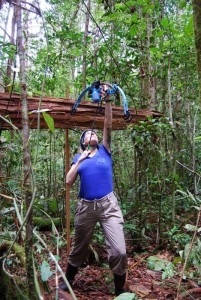
Andrea takes aim with her bow-and-arrow in an attempt to collect samples high up in a tree (don”t worry, she”s an expert!)
Finally, and personally, the most important goal to me is to help conserve these amazing animals and the awe-inspiring forests and ecosystems in which the live. By understanding what nutrients orangutans seek out in foraging, we can prioritize the monitoring and conservation of important fruit trees and lianas (and alternative food plants with similar nutrition), as well as their all-important fallback foods. This information may also be useful to rescue and rehabilitation centers and re-introduction projects, who need to know how best to feed captive animals so that they can thrive. Through all of the ups and downs, stresses and apprehensions involved in starting my dissertation research, this goal has propelled me to make this project work.
To read more about Andrea”s project, and watch a video of how she learned to climb trees, visit her Chasing Orangutans article on Boston University”s research website.

